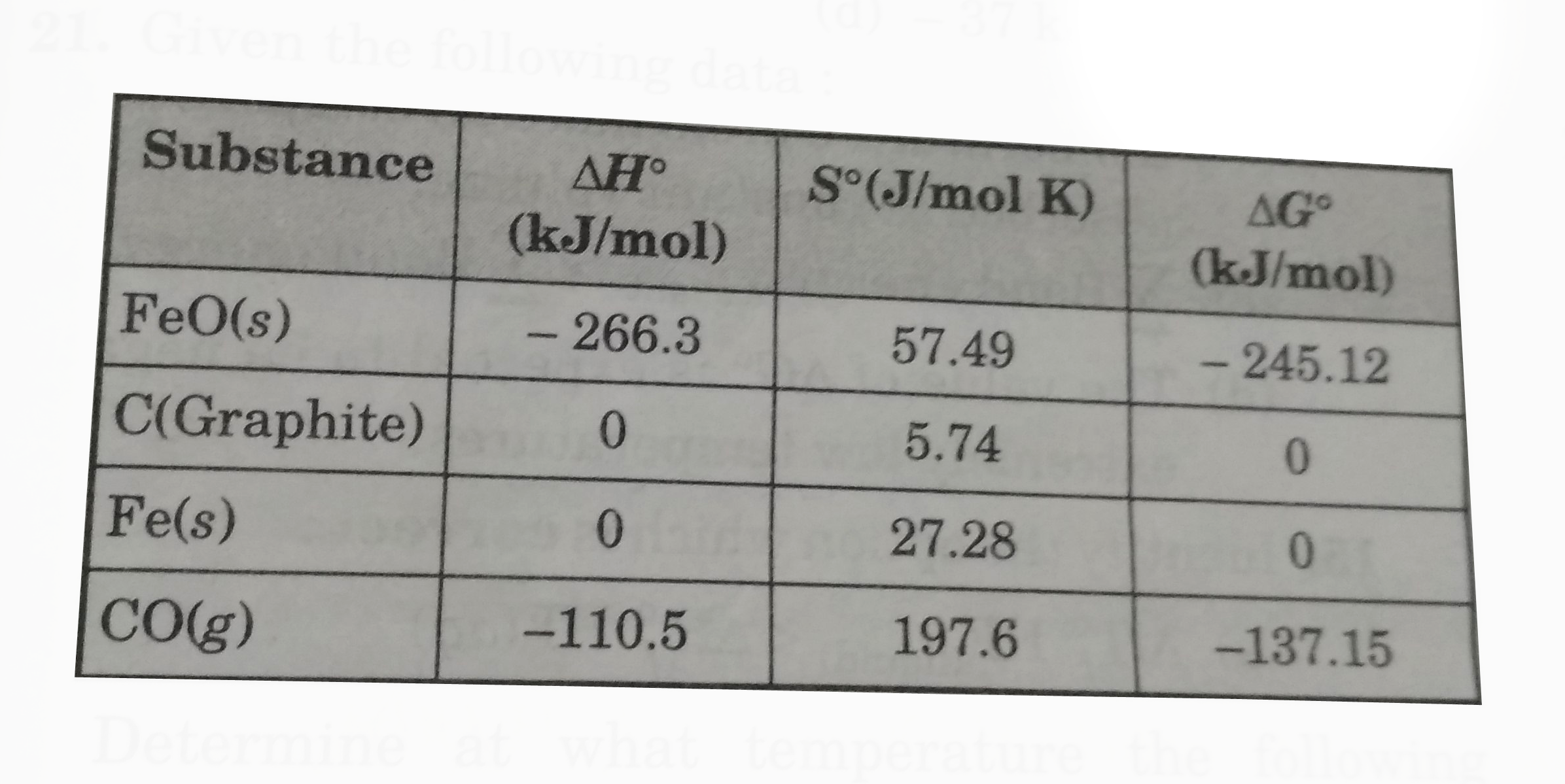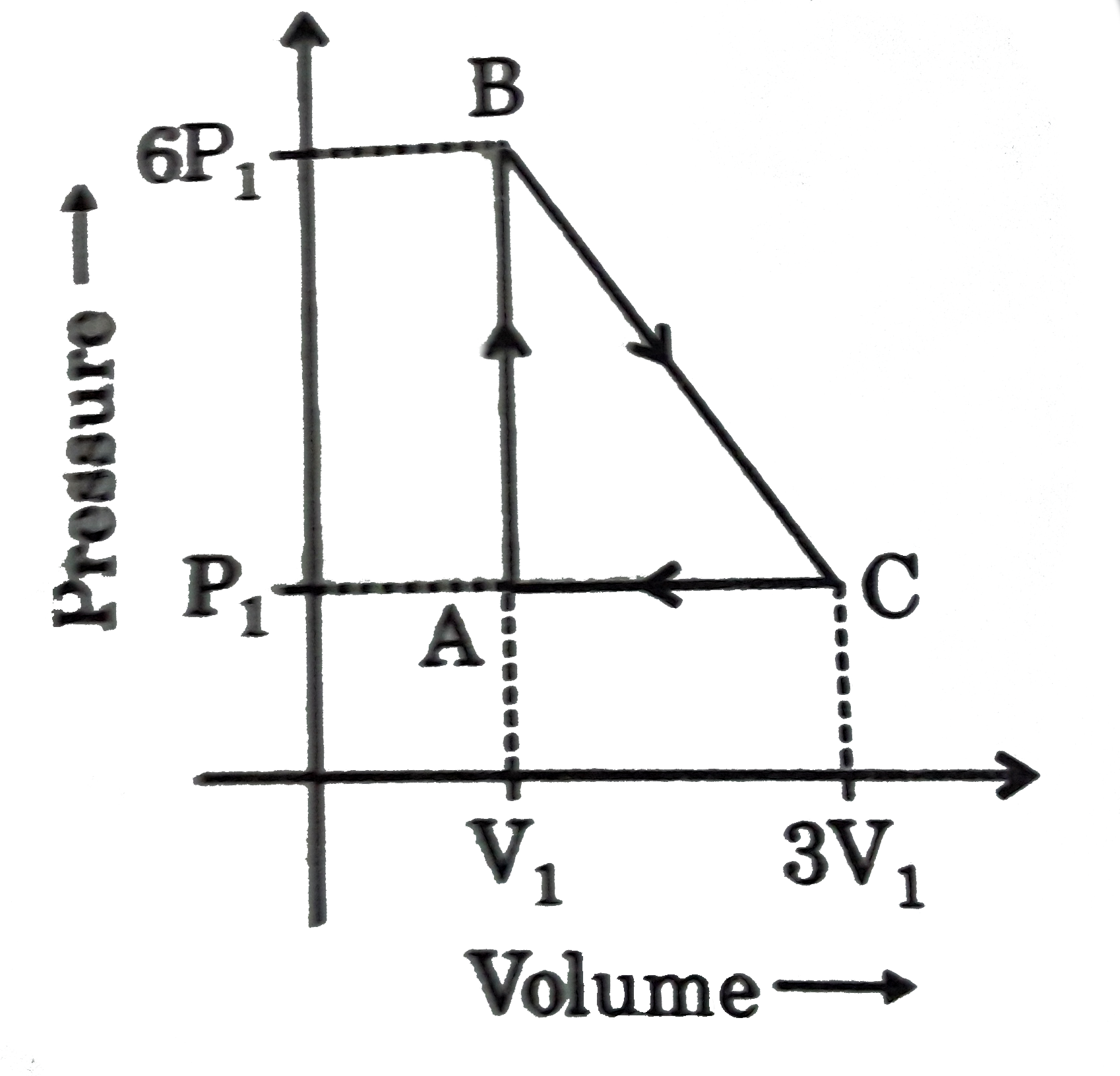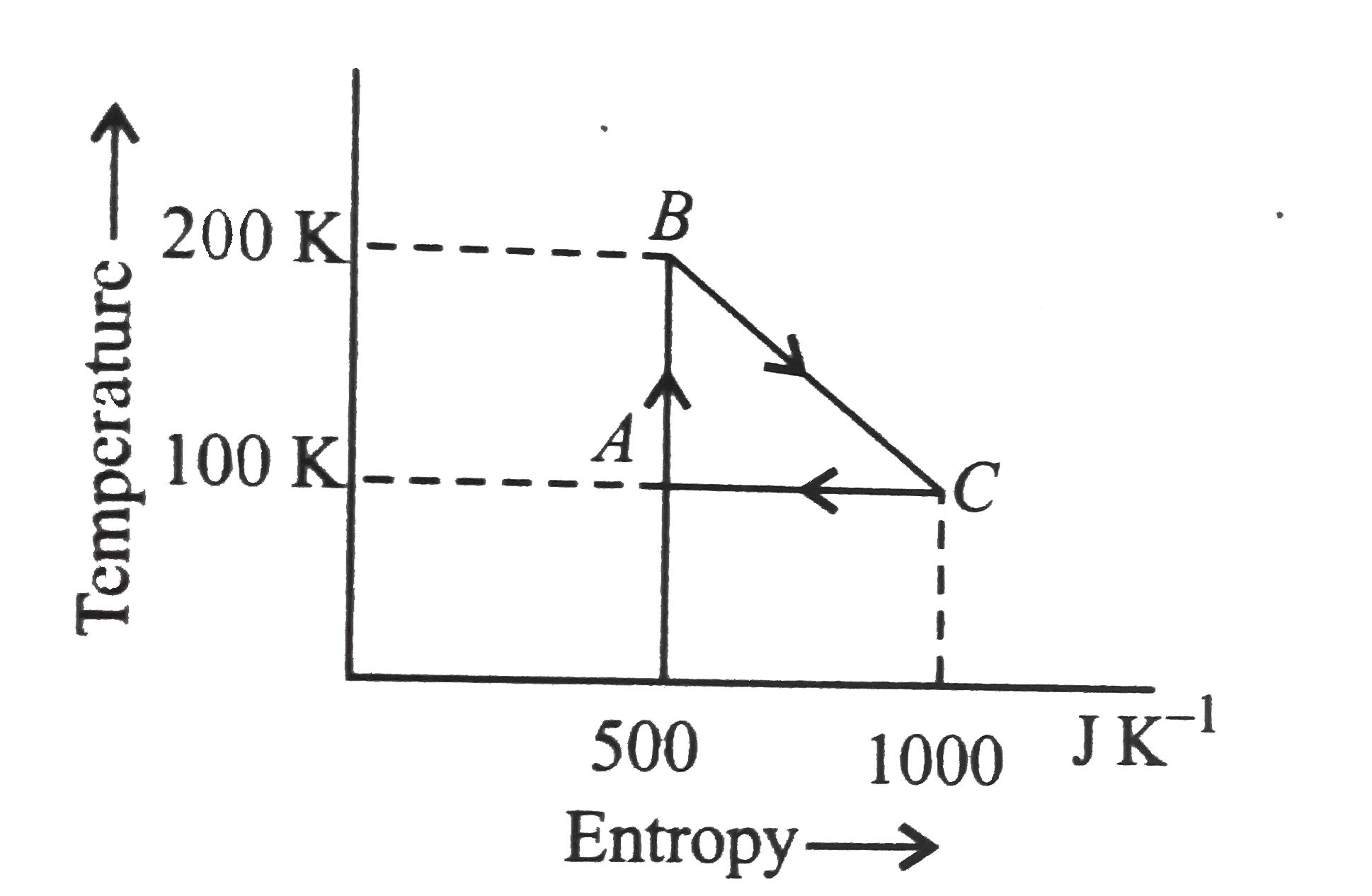Complete Solutions to Objective Question Level B of chapter Chemical Thermodynamics and Thermochemistry of Class 12 book with complete answers and questions
| Class 12 | CHEMISTRY |
| Chapter | Chemical Thermodynamics and Thermochemistry |
| OP TANDON | Objective Question Level B |
| Number Of Questions | 56 |
| Academic Year | 2023-24 |
In which of the following pairs, both proeperties are intensive?
00:51View SolutionAlthough the dissociation of ammonium chloride `(CH_(4)Cl)` in water is an endothermic reaction, even then it is spontaneous because:
01:45View SolutionThe S-S bond energy is if `DeltaH_(f)^(@)(E_(t)-S-E_(t))=-147kJ//mol,DeltaH_(f)^(@)(E_(t)-S-S-E_(t))=-202kJ//mol and DeltaH_(f)^(@)S(g)=+223 kJ//mol:`
02:55View SolutionStandard enthalpies of formation of `O_(3),CO_(3),NH_(3) and HI` are 142.2,-383.2,-46.2 and +25.9kJ `mol^(-1)` respectively. The order of their increasing stabilities will be:
01:29View SolutionConsider the following reaction.
`C_(6)H_(6)(l)+(15)/(2)O_(2)(g)rarr6CO_(2)(g)+3H_(2)O(g)`
signs of `DeltaH, DeltaS` and `DeltaG` for the above reaction will be04:36View SolutionWhich among the following represents the reaction of formation of the product?
02:09View SolutionHow much energy must be supplied to change 36 g of ice at `0^(@)C` to water at room temperature `25^(@)C`? `{:(,"Data for water",),(DeltaH_("fusion")^(@),,6.01kJ//mol),(C_(P" liquid"),,4.18JK^(-1)g^(-1)):}`
03:30View SolutionA large positive value of `DeltaG^(ɵ)` corresponds to which of these?
01:16View SolutionConsider the values of `DeltaH("in" kJ mol^(-))` and for `DeltaS("in" mol^(-)K^(-1))` given for four different reactions. For which reaction will `DeltaG` increases the most (becoming more positive) when the temperature is increased form `0^(@)C "to" 25^(@)C`?
06:12View Solution`Fe_(2)O_(2)(s)+(3)/(2)C(s)to(3)/(2)CO_(2)(g)+2Fe(s)`
`DeltaH^(@)=+234.12KJ `
`C(s)+O_(2)(g)toCO_(2)(g) DeltaH^(@)=-393.5KJ`
Use these equations and `DeltaH^(@)` value to calculate `DeltaH^(@)` for this reaction :
`4Fe(s)+3O_(2)(g)to2Fe_(2)O_(3)(s)`05:45View SolutionConsider this equation and the associated value for `DeltaH^(@)`.
`2H_(2)(g)+2Cl_(2)(g)to4HCl(g),DeltaH=-92.3Kj`
which statement abount this information is incorrect?07:27View SolutionThe internal energy `(U)` of an ideal gas decreases by the same amount as the work done by the system:
03:04View SolutionThe enthalpy of neutralisation of a strong acid by a string base is `-57.32 kJ mol^(-1)`. The enthalpy of formation of water is `-285.84 kJ mol^(-1)`. The enthalpy of formation of hydroxyl ion is
05:57View SolutionFor which process will `DeltaH and DeltaG^(@)` be expected to be most similar?
02:29View SolutionFor a particular reaction, `DeltaH=-38.3 kJ and DeltaS^(@)=-113JxxK^(-1).` This reaction is:
04:49View SolutionWhich halogen in its standard state has the greatest absolute entropy per mole?
02:39View SolutionFor which of these processes is the value of `Delta S` negative?
i. Sugar is dissolved in water.
ii. Steam condenses on a surface.
iii. `CaCO_(3)` is decomposed into `CaO` and `CO_(2)`.04:15View SolutionWhen solid `NH_(4)NO_(3)` is dissolved in water at `25^(@)C`, the temperature of the solution decreases. What is true about the signs of `DeltaH and DeltaS` for this process?
01:54View SolutionThe diagram below shows the heat of reaction between `N_(2),O_(2) NO and NO_(2)`:

Which of the following statements pertaining to the formation of `NO and NO_(2)` are correct?
1. The standard heat of formation of `NO_(2)` is 68 kJ `mol^(-1)`
2. `NO_(2)` is formed faster than NO at higher temperature.
3. The oxidation reaction of nitrogen to `NO_(2)` is endothermic.
4. These two reactions often take place in troposphere and causes green house effect.
5. These two reactions often take place and are responsible for city smog.View SolutionThe enthalpy changes for two reactions are given by the equations:
`2Cr(s) +(3)/(2)O_(2)(g) rarr Cr_(2)O_(3)(s), DeltaH^(Theta) =- 1130 kJ`
`C(s) +(1)/(2)O_(2)(g)rarr CO(g), DeltaH^(Theta) =- 110 kJ`
What is the enthalpy change in `kJ` for the following reactions?
`3C(s) +Cr_(2)O_(3)(s) rarr 2Cr(s) +3CO(g)`04:15View SolutionThe enthalpy changes at 298 K in successive breaking of `O-H` bonds of water, are
`H_(2)O(g) rarr H(g)+OH(g),DeltaH=498kJ mol^(-1)`
`OH(g) rarr H(g)+O(g), DeltaH =428 kJ mol^(-1)`
The bond energy of the O-H bond is01:25View SolutionConsider the following two reactions:
i. Propene `+H_(2) rarr` Propane, `DeltaH_(1)`
ii. Cyclopropane `+H_(2) rarr` Propane, `DeltaH_(2)` Then, `DeltaH_(2) - DeltaH_(1)` will be:04:44View SolutionUnder which circumstances would the free energy change for a reaction be relatively temperature independent?
02:59View SolutionUsing the Gibbs energy change, `Delta G^(@)=+ 63.3 kJ`, for the following reaction,
`Ag_(2)CO_(3)hArr2Ag^(+)(aq)+CO_(3)^(2-)`
the `K_(sp)` of `Ag_(2)CO_(3)(s)` in water at `25^(@)C` is
`(R=8.314 JK^(-1)mol^(-1))`05:52View SolutionWhich statement (s) is/are true?
1. `S^(Theta)` values for all elements in their states are positive.
2. `S^(Theta)` values for all aqueous ions are positive.
3. `DeltaS^(Theta)` values for all spontaneous reactions are positive.04:45View SolutionThe enthalpy of reaction does not depend upon:
02:37View SolutionA solution of `200 mL` of `1 M KOH` is added to `200 mL` of `1 M HCl` and the mixture is well shaken. The rise in temperature `T_(1)` is noted. The experiment is repeated by using `100 mL` of each solution and increase in temperature `T_(2)` is again noted. Which of the following is correct?
05:55View SolutionThe heat of combustion of solid benzoic acid at constant volume is `-321.30 kJ` at `27^(@)C`. The heat of combustion at constant pressure is
04:00View Solution`AtoB," "DeltaU=40kJ" "mol^(-1)`
If the system goes from A to B by a reversible path and returns to state A by an irreversible path, what would be the net change in internal energy?01:35View SolutionFor the process
`NH_(3)(g) +HCI(g) rarr NH_(4)CI(s)`01:11View SolutionA gas is allowed to expand reversibly under adiabatic conditions. What is zero for such a process ?
01:10View SolutionGiven the following data :

Determine at what temperature the following reaction is spontanous?
`FeO(s)+C_("graphite")toFe(s)+CO(g)`02:50View SolutionWhich of the following equations has/have enthalpy changes equal to `DeltaH_(comb)C`?
I. `C(s)+O_(2)(g)toCO_(2)(g)`
II. `C(s)+(1)/(2)O_(2)(g)toCO(g)`
III. `CO(g)+(1)/(2)O_(2)(g)toCO_(2)(g)`01:31View SolutionThe enthalpy change of which reaction corresponds to `DeltaH_(f)^(@) "for"Na_(2)CO_(3)(s)298K?`
01:28View SolutionEnthalpy is equal to
01:33View SolutionWhen a bomb calorimeter is sued to determine the heat of reaction, which proper
View SolutionFor the reaction shown , which which is closest to the value o f`DeltaH`?
`{:(DeltaH_(f)^(@),(KJ.mol^(-1))),(Cr^(3+)(aq),-143),(Ni^(2+) (aq),-54):}`
`2Cr^(3+)(aq)+3Ni(s)to2Cr(s)+3Ni^(2+)(aq)`01:35View SolutionAn ice cube at `0.00^(@)C` is placed is 200g of distilled water at `25^(@)C`. The final temperature after ithe ice is completely metled is `5.00^(@)C`. What is the mass of the ice cube?
`deltaH_(fus)=340J.g^(-1), C_(p)=4.18 J.g^(-1). .^(@)C^(-1)`04:01View SolutionWhich reaction occurs with the greatest increase in entropy?
01:47View SolutionThe table given below lists the bond dissociation energy `(E_("diss"))` for single covalent bonds formed between C and atoms A, B, D, E.
`{:("Bond",,,E_("diss")("kcal mol"^(-1))),(C-A,,," "240),(C-B,,," "382),(C-D,,," "276),(C-E,,," "486):}`
Which of the atoms has smallest size ?02:35View SolutionAn ideal gas is taken around the cycle ABCA as shown in P-V diagram. The net work done by the gas during the cycle is equal to :
 04:20View Solution
04:20View SolutionOne gram mole of graphite and diamond were burnt to form `CO_(2)` gas:
`C_(("graphite"))+O_(2)(g)toCO_(2)(g)," "DeltaH^(@)=-399.5kJ`
`C_(("diamond"))+O_(2)(g)toCO_(2)(g)," "DeltaH^(@)=-395.4 kJ`02:44View SolutionWhich among the following is not an exact differential?
03:01View SolutionA gas expands adiabatically at constant pressure such that:
`T prop(1)/(sqrt(V))`
The value of `gamma` i.e., `(C_(P)//C_(V))` of the gas will be:01:20View Solution`2Zn+O_(2)to2ZnO," "DeltaG^(@)=-606J` . . . (i)
`2Zn+2Sto2ZnS," "DeltaG^(@)=-293J` . . .(ii)
`2S+2O_(2)to2SO_(2)(g)," "DeltaG^(@)=-408J` . . . (iii)
`DeltaG^(@)` for the following reaction
`2ZnS+3O_(2)to2ZnO+2SO_(2)`
would be:03:59View SolutionThe efficiency of the reversible cycle shown in the given figure is
 03:55View Solution
03:55View SolutionIN Haber's process of manufacturing of ammonia :
`N_(2)(g)+3H_(2)(g)to2NH_(3)(g),H_(25^(@)C)^(@)=-92.2 kJ`
Molecule `N_(2)(g)` `H_(2)(g)` `NH_(3)(g)`
`C_(p)JK^(-1)` 29.1 28.8 35.1
If `C_(p)` is independent of temperature, then reaction at `100^(@)` C as compared to that of `25^(@)` C will be :03:29View SolutionConsider the following statements:
I. Change in enthalpy is always smaller than change in internal energy.
II. The variation in enthalpy of a reaction with temperature is given by Kirchhoff's equation.
III. The entropy change in reversible adiabatic process is equal to zero.
Select the correct answer.03:09View SolutionIn `C_(2)H_(4)` energies of formation of `(C=C) and (C-C)` are -145 kJ/mol and -80kJ/mol respectively. What is the enthalpy change w hen ethylene polymerises to form polythene?
02:42View SolutionIf `150 kJ` of energy is needed for muscular work to walk a distance of one km, than how much of gulcose one has to consume to walk a distance of five km, provided only `30%` energy is available for muscular work.The enthalpy of combustion of glucose is `3000 kJ mol^(-1)`
03:23View SolutionThe value of `1og_(10)` K for a reaction `AhArrB` is:
(Given, `Delta_(r)H_(298K)^(@)=-54.07kJ" "mol^(-1),Delta_(r)S_(298K)^(@)=10JK^(-1)" "mol^(-1) and R=8.314JK^(-1)" "mol^(-1),2.303xx8.314xx298=5705`)02:21View SolutionThe lattice enthalpy and hydration enthalpy of four compounds are given below:

the pair of compounds which is soluble in water is:01:55View SolutionThe standard enthalpies fo formation of `CO_(2) (g), H_(2) O (1)`, and glucose (s) at `25^(@)C` are `- 400 kJ mol^(-1), - 300 kJ mol^(-)`, and `- 1300 kJ mol^(-1)`, respectively. The standard enthalply of combustion per gram of glucose at `25^(@)C` is
06:21View SolutionFor the process `H_(2)O(l)toH_(2)O(g)` at `t=100^(@)C` and 1 atmosphere pressure, the correct choice is:
01:47View Solutionone mole of an ideal gas at 300k in thermal contact with surroundings expands isothermally from 1.0 L to 2.0 L against a constant presses of 3.0 atm. In this process. The change in entropy of surrroundings `(DeltaS)` in `J^(-1)` is
(1 L atm = 101.3 J)04:49View SolutionThe standard state Gibbs free energies of formation of ) C(graphite and C(diamond) at T = 298 K are
`Delta_(f)G^(@)["C(graphite")]=0kJ mol^(-1)`
`Delta_(f)G^(@)["C(diamond")]=2.9kJ mol^(-1)`
The standard state means that the pressure should be 1 bar, and substance should be pure at a given temperature. The conversion of graphite [ ) C(graphite ] to diamond [C(diamond)] reduces its volume by `2xx10^(-6)m^(3) mol^(-1).` If ) C(graphite is converted to C(diamond) isothermally at T = 298 K, the pressure at which ) C(graphite is in equilibrium with C(diamond), is
`["Useful information:"1J=1kg m^(2)s^(-2),1Pa=1kgm^(-1)s^(-2),1"bar"=10^(5)Pa]`03:43View Solution
Objective Question Level B questions and complete solutions for chapter Chemical Thermodynamics and Thermochemistry of G.R. BATHLA & SONS CHEMISTRY (HINGLISH) of Class 12
All Exercises from OP TANDON Class 12 CHEMISTRY Chemical Thermodynamics and Thermochemistry
- Assertion Reason Type Question
- Assertion Reason Type Question Set-2
- Example
- Illustrations of Objective Questions
- Integer Type
- Linked Comprehension Type Questions
- Matric Matching Type Questions
- Miscellaneous Numerical Examples
- Objective Question Level B
- Objective Question Level B Set II
- Objective Question Level-A
- Practice problems
- Self Assessment
- Self Assessment (Assertion Reason)
- Self Assessment (Integer type).
- Self Assessment (Matrix Type)
- Self Assessment (Multiple Choice)
- Set 2
- Solved Example
